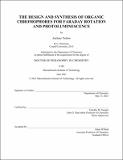| dc.description.abstract | This thesis summarizes the design, synthesis, and application of novel small-molecule and polymeric materials, with emphasis on understanding and tuning the chromophore electronic structure to maximize properties including Faraday rotation and delayed fluorescence.
In Chapter 1, we introduce the magneto-optical property Faraday rotation. The current frontiers in performance, applications, and mechanistic understanding of Faraday rotation in organic-chromophore thin-films is discussed. Faraday rotation measurements of several novel materials are introduced in context.
In Chapter 2, we evaluate the Faraday rotation in thin films of several phthalocyanine and porphyrin derivatives, and observe maximum Verdet constants greater than those found in competing inorganic materials. The effect of chemical modifications, including the introduction of paramagnetic and chiral centers, is discussed.
In Chapter 3, we evaluate the Faraday rotation in thin films of π-conjugated polymers when influenced by chiral moieties. We demonstrate the key role chirality serves in the magneto-optical properties of these materials, the influence of structural order and film thickness on Faraday rotation, and report among the largest Verdet constants observed to date in organic thin films.
In Chapter 4, we develop the polymerization for and evaluate the properties of a new class of polyarylene chalcogenides. We utilized dynamic covalent SNAr behavior to demonstrate selective depolymerization. In addition, we studied the mechanism of the bright photoemission, ascribing it to delayed fluorescence enabled by the presence of sulfur atoms.
In Chapter 5, we discuss the synthesis and properties of two classes of solution-processable materials: M(III) and Au(I) arylthiolate coordination polymers. We demonstrate the presence of strong metal–metal interactions between M(III) centers along the polymer backbone. Further, we discuss the strong phosphorescence and dynamic supramolecular coordination in the solution phase of the Au(I) coordination polymers. | |
